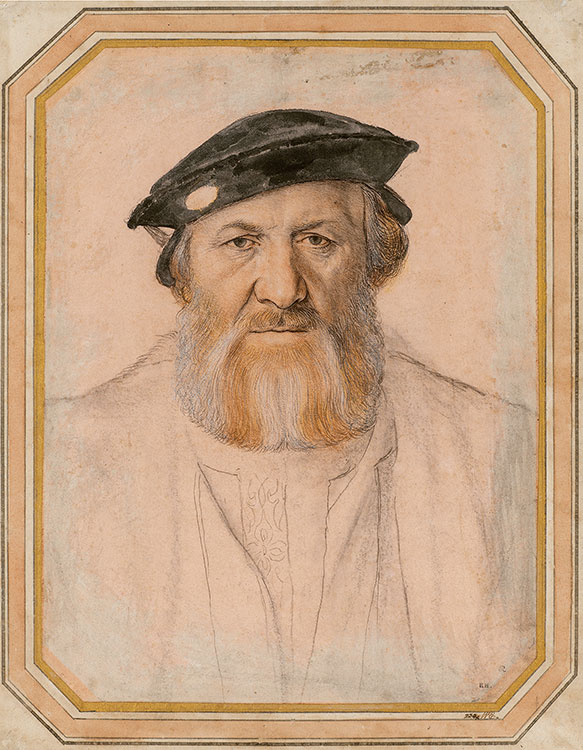
Born in Germany and first active as an independent master in Switzerland, Holbein spent the final decade of his life in England, working in the ambit of the Tudor court. He was particularly admired for his skills as a portraitist. This imposing likeness of Charles de Solier—a French nobleman, soldier, and diplomat—exemplifies the multilayered drawing technique that Holbein developed for his portrait studies around this time. The artist used paper prepared with a light-pink ground, approximating his sitter’s skin tone. Subtle modeling in black and colored chalk helped animate the frontal likeness, drawing the viewer’s attention to Solier’s pensive gaze. Perhaps most striking, however, is Holbein’s meticulous rendering of the man’s beard, composed of gray and auburn streaks.
Hans Holbein the Younger
German, 1497/98–1543
Portrait of Charles de Solier, Comte de Morette, 1534–35
Black and colored chalk, pen and brown ink, black wash, and white opaque watercolor on pink prepared paper
Kupferstich-Kabinett, Staatliche Kunstsammlungen Dresden, INV. NO. C 1977-156
Austeja Mackelaite, Annette and Oscar de la Renta Assistant Curator of Drawings and Prints
The man gazing directly at us from this image is Charles de Solier, French soldier and diplomat, who acted as French ambassador to England on a number of occasions from 1526 to 1535. We know that he stayed in London from April 1534 to July of the following year, which is when he commissioned Hans Holbein the Younger to make this portrait. The artist started as he always did—by making a detailed and strikingly naturalistic study of the man’s face. He used a wide range of drawing media at his disposal—black and colored chalks, black ink and wash, and white opaque watercolor, all layered to achieve uncannily realistic effects. While the finished painted portrait is dominated by the sumptuous clothes and jewelry worn by the sitter, in the drawn study, the clothing is only suggested with a few lines of black chalk.
The drawing was acquired by the Dresden museum shortly after it was auctioned in London in 1860 as part of the collection of Samuel Woodburn, English art dealer. One of the reasons for the purchase was the desire to reunite the drawing with the finished painted portrait of de Solier, which had entered the Dresden collection more than a century earlier. The painting and the drawing hung side by side in the Dresden Picture Gallery for many decades that followed, inviting visitors to compare Holbein’s work in these two different media.
